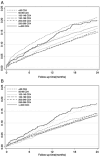CD4 count at antiretroviral therapy initiation and the risk of loss to follow-up: results from a multicentre cohort study
- PMID: 26700300
- PMCID: PMC4865447
- DOI: 10.1136/jech-2015-206629
CD4 count at antiretroviral therapy initiation and the risk of loss to follow-up: results from a multicentre cohort study
Abstract
Background: Antiretroviral therapy (ART) initiation is now recommended irrespective of CD4 count. However data on the relationship between CD4 count at ART initiation and loss to follow-up (LTFU) are limited and conflicting.
Methods: We conducted a cohort analysis including all adults initiating ART (2008-2012) at three public sector sites in South Africa. LTFU was defined as no visit in the 6 months before database closure. The Kaplan-Meier estimator and Cox's proportional hazards models examined the relationship between CD4 count at ART initiation and 24-month LTFU. Final models were adjusted for demographics, year of ART initiation, programme expansion and corrected for unascertained mortality.
Results: Among 17 038 patients, the median CD4 at initiation increased from 119 (IQR 54-180) in 2008 to 257 (IQR 175-318) in 2012. In unadjusted models, observed LTFU was associated with both CD4 counts <100 cells/μL and CD4 counts ≥300 cells/μL. After adjustment, patients with CD4 counts ≥300 cells/μL were 1.35 (95% CI 1.12 to 1.63) times as likely to be LTFU after 24 months compared to those with a CD4 150-199 cells/μL. This increased risk for patients with CD4 counts ≥300 cells/μL was largest in the first 3 months on treatment. Correction for unascertained deaths attenuated the association between CD4 counts <100 cells/μL and LTFU while the association between CD4 counts ≥300 cells/μL and LTFU persisted.
Conclusions: Patients initiating ART at higher CD4 counts may be at increased risk for LTFU. With programmes initiating patients at higher CD4 counts, models of ART delivery need to be reoriented to support long-term retention.
Keywords: EPIDEMIOLOGY; HIV; INTERNATIONAL HLTH; LONGITUDINAL STUDIES.
Published by the BMJ Publishing Group Limited. For permission to use (where not already granted under a licence) please go to http://www.bmj.com/company/products-services/rights-and-licensing/
Figures



References
-
- UNAIDS. The gap report. Geneva: UNAIDS; 2014.
-
- World Health Organization. Global update on HIV treatment 2013: results, impact and opportunities. Geneva: World Health Organization; 2013.
-
- World Health Organization. Antiretroviral therapy for HIV infection in adults and adolescents: recommendations for a public health approach (2006 revision) Geneva: World Health Organization; 2006. - PubMed
-
- World Health Organization. Antiretroviral therapy for HIV infection in adults and adolescents: recommendations for a public health approach. Geneva: World Health Organization; 2010. - PubMed
-
- World Health Organization. Consolidated guidelines on the use of antiretroviral drugs for treating and preventing HIV infection: recommendations for a public health approach. Geneva: World Health Organization; 2013. - PubMed
Publication types
MeSH terms
Substances
Grants and funding
LinkOut - more resources
Full Text Sources
Other Literature Sources
Medical
Research Materials
